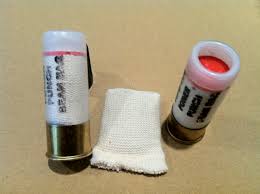Blunt Force

An example of a
"military" or "tactical" pen with glass
breaker.
For many people, blunt force is the simplest,
easiest, and cheapest self defense they will ever
need. But why is it so effective? Why not just learn
martial arts and call it good? In fact, according to
Cindy Bir, a Bio-medical Engineer at Wayne State
University, the average boxer is capable of throwing
punches with almost 5,000 newtons of force behind
them! And that's just their upper body! The same
sample group Bir used was also capable of throwing
9,000 newton kicks! That's roughly half the energy
in a standard 55 grain .223 Remington bullet at the
muzzle of the rifle! That force dissipates with time
and gravity as well!
This is a great point as it also disproves itself
with Newton's Third Law: For every action, there is
an opposite and equal reaction. That same 5,000 N
force from the punch that the boxer threw also
reflected back onto the boxer as a normal force.
Now, boxers train to be able to throw hard punches,
but they also wrap their hands during training as
well as wearing padded gloves in the ring. Why? To
give their hands a bit of cushioning. Otherwise the
normal force of the punch would most likely break
the boxer's hands! look at the following diagram:

Force Diagram of
Boxer punching a sand
bag
As you can most likely tell, the glove
will compress and act as a cushion,
reducing the force of the punch, and
thus reducing normal force, to ensure
that no bones break. However, throwing a
proper punch requires a lot more
technique than most people know, and
while most people can throw one with
ease, their hand will not like them
afterward even with significant padding.
Another problem is that regardless of
how much force we put behind an attack,
the human body will almost always
cushion somewhat due to the nature of
bio-organic materials. They are also
prone to breakage when exposed to shot
bursts of extreme force, surrendering
the usefulness of bone's surprising
compression strength.
This is where blunt force objects come
in. Now, this could be anything from a
stick to a hammer to a pool cue to a
even pen. The primary purpose of a blunt
force objects is to allow the person to
use their full strength with less
repercussions on the body. They are
typically easy to manipulate, and are
made of a material harder and usually
more dense than human bio-mass. They
also tend to be small or have a narrow
striking surface, such as the pen at the
top of the page, to increase pressure at
a smaller area. This results in a tool
that allows someone to focus the force
behind their strikes to ensure maximum
effectiveness.

Pressure of an elbow
striking an object vs pressure of a
pen tip striking an object
Shotguns and rifles can also take
advantage of blunt force with special
ammunition that uses a beanbag or rubber
for a projectile. These are most often
employed by police to incapacitate
violent suspect. In this application, it
is ideal for the ammunition to have a
larger striking face to prevent the
round from entering the target and
causing severe damage.

Less than lethal shotgun
rounds.
It should be noted that while blunt
force objects are the easiest to obtain,
they are also very easy to mishandle,
resulting in fatal injuries to the user
and target. Blunt force objects, as with
any less than lethal weapons, should be
used only to incapacitate the threat and
as a means to get to safety unless there
is no other options. |



